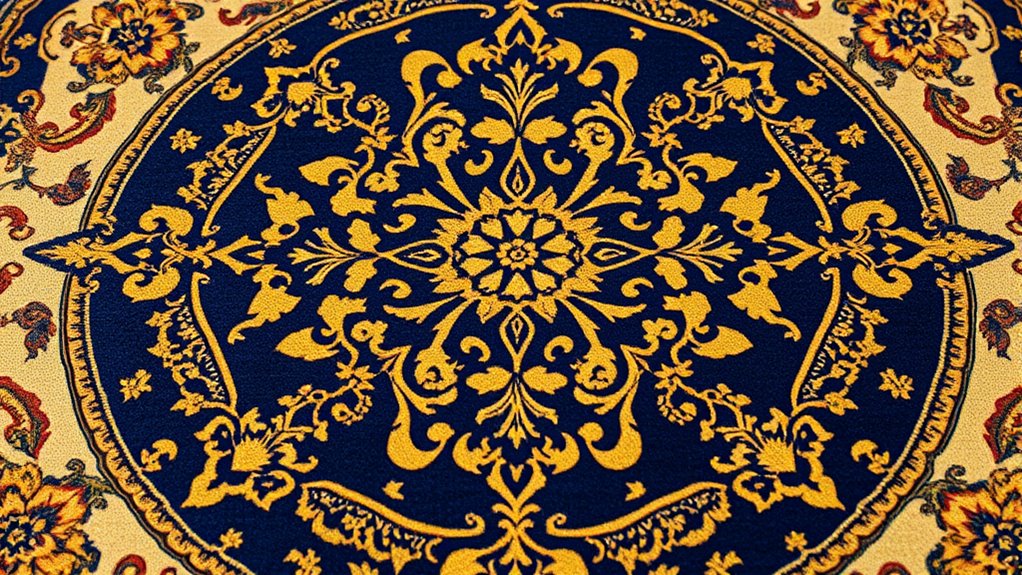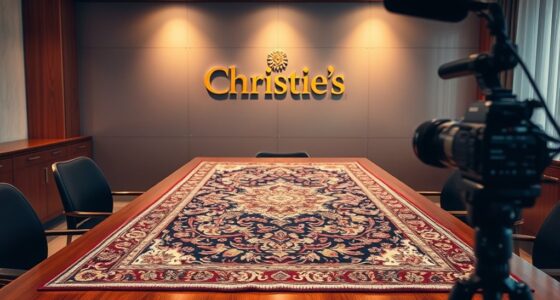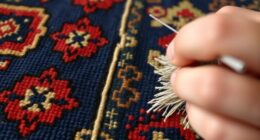Royal provenance rugs showcase centuries of craftsmanship, symbolism, and cultural pride. Iconic pieces like the Ardabil Carpet and Pahlavi Carpet reveal Persian artistry, while Mughal silk rugs highlight imperial elegance. These textiles often include intricate motifs, advanced dyeing techniques, and symbols of authority. They serve as visual stories of history and tradition, emphasizing resilience and craftsmanship. To uncover more about their lessons and significance, keep exploring these remarkable treasures and what they reveal about royal culture.
Key Takeaways
- Iconic royal rugs like the Ardabil and Tabriz exemplify Persian craftsmanship, symbolism, and advanced dyeing techniques.
- Royal textiles often incorporate heraldic motifs and mythological symbols reflecting authority, spirituality, and cultural identity.
- Techniques such as intricate embroidery and knotting highlight the mastery and craftsmanship of royal textile artisans.
- These rugs serve as historical artifacts, conveying cultural stories, social hierarchy, and political power through design.
- Preservation and display of royal provenance rugs emphasize their educational, artistic, and cultural significance across history.
The Pahlavi Carpet: A Symbol of National Pride

The Pahlavi Carpet stands as a powerful symbol of Iran’s national pride, reflecting the country’s rich cultural heritage and craftsmanship. Its intricate weaving symbolism reveals stories and values deeply rooted in Iranian tradition, making each knot meaningful. The carpet’s vivid colors result from advanced dyeing techniques, showcasing expert use of natural dyes to achieve lasting, vibrant hues. These dyeing methods add depth and complexity to the design, highlighting the skill of artisans who carefully select and prepare materials. As you examine the carpet, you see how weaving symbolism and dyeing techniques blend seamlessly, creating a masterpiece that embodies Iran’s artistic legacy. The Pahlavi Carpet isn’t just a decorative piece; it’s a testament to Iran’s cultural resilience and meticulous craftsmanship. Additionally, understanding the integration of emerging technologies in traditional crafts can inspire innovative preservation and restoration methods to safeguard such cultural treasures for future generations.
The Ardabil Carpet: An Imperial Masterpiece
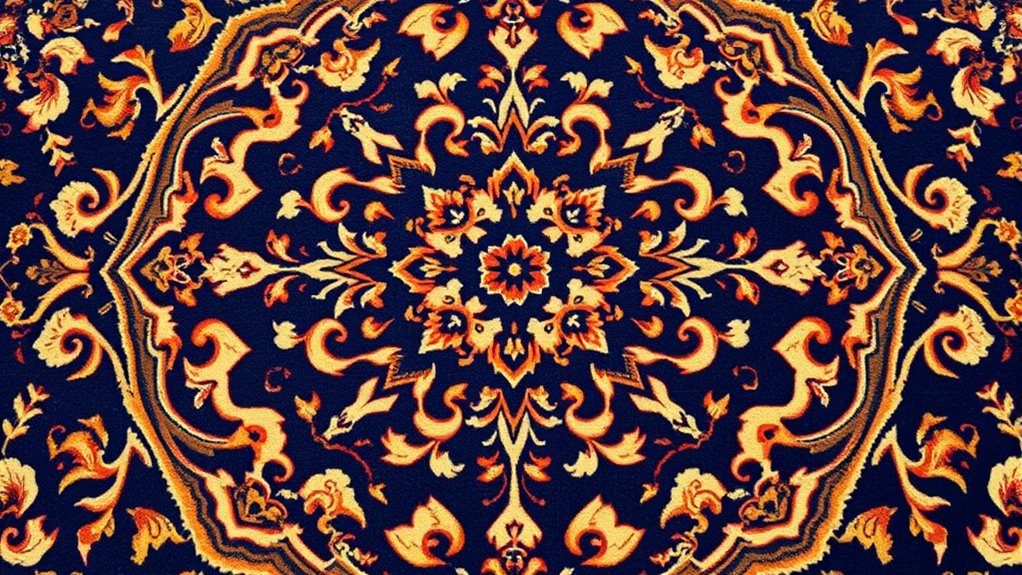
As one of the most celebrated examples of Persian craftsmanship, the Ardabil Carpet exemplifies imperial artistry and historical significance. You can admire its intricate weaving motifs that depict complex floral and geometric patterns, reflecting the skill of master weavers. The dyeing techniques used reveal a deep understanding of natural color extraction, resulting in vibrant, lasting hues. This carpet’s design balances symmetry and detail, showcasing refined craftsmanship. Its size and quality were meant to impress, symbolizing power and cultural richness. The craftsmanship involved precise knotting and layering, which made it durable and visually stunning. Discover how these weaving motifs and dyeing techniques combined to create a masterpiece that endures as a symbol of Persian heritage. Variations in color and pattern highlight the artistry behind this imperial treasure. The craftsmanship involved precise knotting and layering, which made it durable and visually stunning.
The Ardabil Carpet: An Imperial Masterpiece
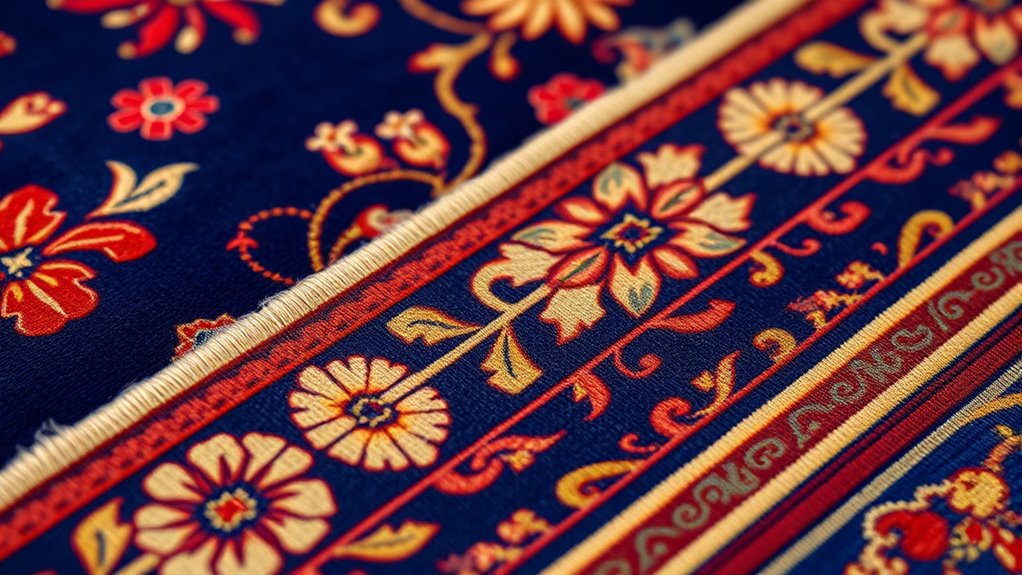
Since its creation, the Ardabil Carpet has stood as a symbol of Persian artistry and imperial prestige. Its intricate weaving symbolism reflects the cultural and spiritual values of the Safavid era, showcasing masterful craftsmanship. You’ll notice the precision in the knotting techniques, which contribute to its durability and detailed design. The dye techniques used are particularly remarkable, employing rich, vibrant colors derived from natural sources that have aged beautifully over centuries. These dyes not only enhance the carpet’s visual impact but also demonstrate advanced knowledge of color mastery. Moreover, the detailed weaving symbolism integrated into the design reveals a deep connection to Persian history and religious motifs, elevating the carpet from a decorative object to a cultural artifact. As you observe the carpet, you appreciate how weaving symbolism and dye techniques combine to create an imperial masterpiece that embodies Persia’s artistic and cultural excellence.
The David Collection’s Mughal Rugs: A Royal Treasure
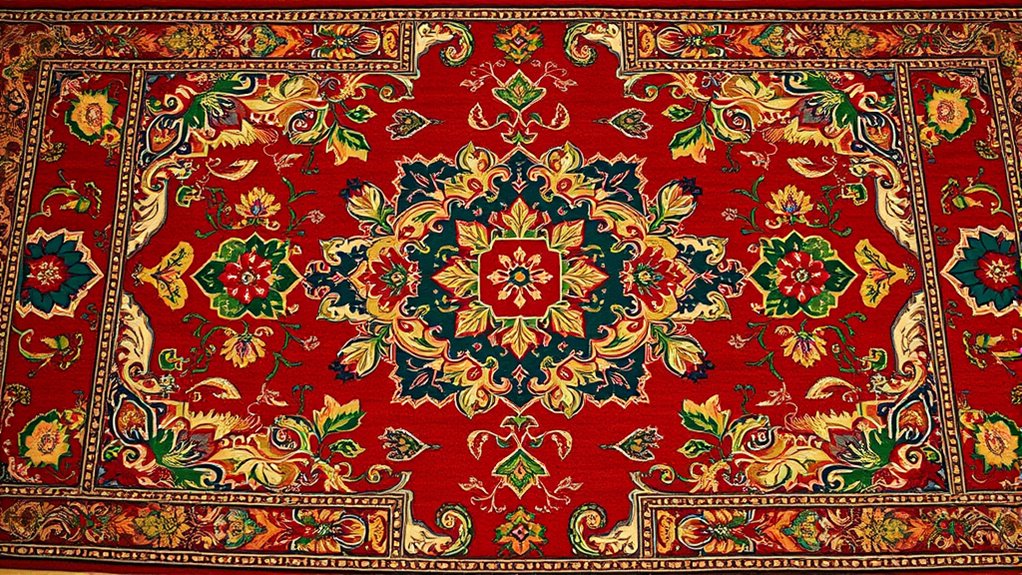
Have you ever wondered how Mughal rugs from the David Collection exemplify royal craftsmanship and cultural richness? These masterpieces showcase intricate weaving techniques that highlight the skill of artisans and the importance of rug symbolism in Mughal art. The collection features rugs with complex patterns, vivid colors, and detailed motifs representing royal authority and spiritual beliefs. You’ll notice how the weaving techniques create a sense of depth and texture, elevating each piece to a work of art. These rugs weren’t just decorative; they conveyed status and cultural values. The collection offers a glimpse into Mughal life, blending craftsmanship with symbolism. Explore how every knot and pattern reflects the grandeur and spiritual depth of Mughal royal culture. Additionally, the symbolism embedded in these rugs reveals insights into Mughal values and beliefs.
The Tabriz Rugs of the Qajar Dynasty
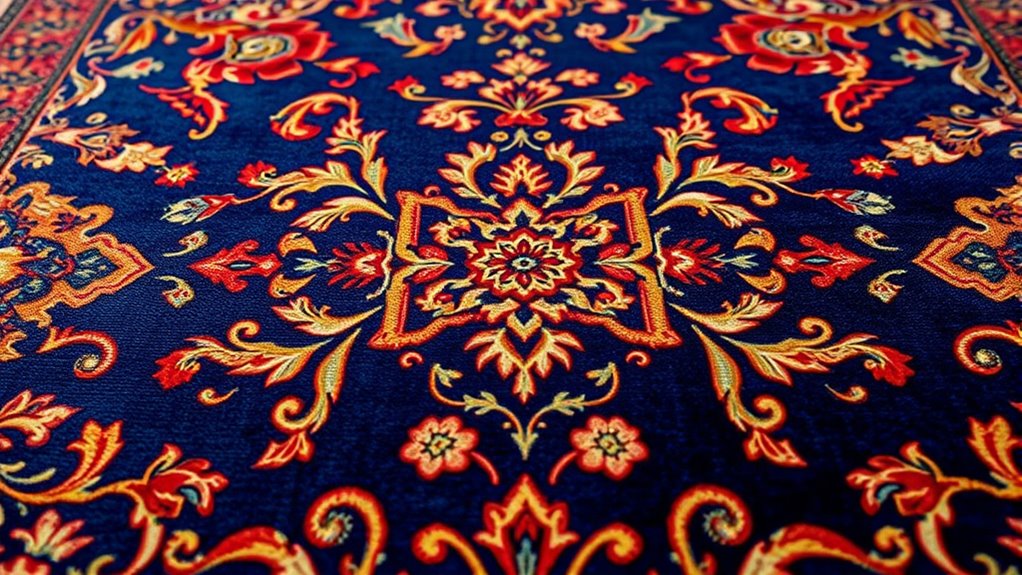
The Tabriz rugs of the Qajar dynasty stand as stunning exemplars of Persian artistry, reflecting both royal prestige and sophisticated craftsmanship. You’ll notice their intricate weaving techniques, which include fine knotting and detailed patterns, demonstrating the weavers’ mastery. The dyeing methods used are equally impressive, employing natural dyes that produce vibrant, long-lasting colors. These rugs often feature elaborate floral motifs, medallions, and symmetrical designs that highlight the artisans’ skill. During the Qajar period, Tabriz weavers refined their techniques, creating pieces that combine artistic beauty with durability. As a result, these rugs serve as both functional textiles and symbols of aristocratic power. Their rich colors and detailed craftsmanship continue to make Tabriz rugs highly prized among collectors and enthusiasts today. Additionally, market value for these pieces has increased over time, reflecting their importance and desirability in the world of fine art and antiques.
The Pashmina Silk Rugs From the Mughal Empire

Did you know that Mughal emperors elevated the art of silk weaving to new heights with their exquisite Pashmina rugs? These luxurious pieces showcase masterful craftsmanship, blending intricate designs with rich, vibrant colors. The Mughal artisans perfected dyeing techniques, using natural dyes to achieve deep, lasting hues. Their silk weaving process involved fine, delicate fibers, creating soft yet durable rugs fit for royalty. Pashmina silk rugs often depict floral motifs, paisleys, and detailed medallions, reflecting Persian influences. The combination of skillful dyeing and weaving techniques resulted in textiles that are both visually stunning and historically significant. These rugs served not just as decor but as symbols of imperial power and cultural sophistication, making them highly prized collectibles today. Additionally, the dyeing techniques used by Mughal artisans contributed to the distinctive brilliance and longevity of these textiles.
The Safavid Sultan’s Court Rugs

Building on the opulence of Mughal silk artistry, the Safavid Sultan’s Court Rugs exemplify Persia’s mastery in creating luxurious textiles that symbolize imperial grandeur. These dynastic textiles were crafted specifically for court ceremonial events, reflecting the sultan’s authority and cultural sophistication. The intricate designs often feature symmetrical patterns, floral motifs, and vibrant colors, showcasing the artisans’ skill and attention to detail. As a central element in palace decor, these rugs served both practical and symbolic purposes, emphasizing the importance of court rituals. Their durability and beauty made them prized possessions, often commissioned to display the wealth and power of the Safavid dynasty. The extraction process used in making these rugs contributed to their fine craftsmanship and detailed patterns. Today, these rugs remain iconic symbols of Persia’s artistic legacy, embodying the grandeur of the courtly tradition.
The Crown Jewels of Persia: Embroidered and Tapestry Rugs

You’ll notice that Persian embroidered and tapestry rugs showcase exceptional craftsmanship through their intricate embroidery techniques. These rugs often carry rich symbolism, reflecting cultural values and royal status. Exploring their craftsmanship and meaning reveals why they’re considered Persia’s true crown jewels. Additionally, the use of vintage decor and traditional motifs emphasizes their historical significance and timeless beauty.
Regal Embroidery Techniques
Regal embroidery techniques elevate Persian rugs to true works of art, showcasing intricate craftsmanship and rich cultural symbolism. These techniques, rooted in medieval embroidery and royal textile methods, highlight the skill and artistry passed down through generations. The detailed stitching, often involving gold and silver threads, creates a luxurious texture that reflects royal status. You’ll notice the use of elaborate motifs, precise knotting, and complex patterns that symbolize power and spirituality. These embroidery styles were reserved for the most prestigious textiles, reserved for royalty and nobility. Understanding these methods deepens your appreciation for the craftsmanship involved, revealing how artisans transformed simple fabrics into regal masterpieces. The mastery of these royal textile techniques makes these rugs invaluable treasures of Persian heritage. Color fidelity in embroidery enhances the richness and visual impact of these exquisite pieces.
Tapestry Rug Symbolism
Tapestry rugs in Persia are more than decorative textiles; they serve as powerful symbols of authority, spirituality, and cultural identity. You’ll notice that medieval symbolism often influences their designs, reflecting the values and beliefs of the time. Mythological motifs, such as phoenixes, lions, and divine creatures, appear prominently, representing strength, protection, and divine favor. These intricate patterns aren’t random; they carry meanings that convey status and spiritual connection. When you examine these rugs, you see stories and symbols woven into every thread, serving as visual sermons and status symbols. Tapestry rugs become timeless messengers of Persia’s rich history, blending artistic mastery with symbolic language that transcends mere decoration, embodying the cultural and spiritual essence of their creators. Additionally, these textiles often incorporate security zone info, emphasizing their role in protecting and asserting social hierarchy.
The Coronation and Royal Event Rugs of Europe

Throughout European history, royal coronations and significant events have often been marked by the use of specialized, ceremonial rugs that symbolize power and tradition. These rugs, often crafted from luxurious materials, feature intricate designs rooted in medieval heraldry and royal symbolism. They serve as a backdrop for coronation chairs, processions, and other key moments, emphasizing lineage and authority. Many of these event rugs were made from royal wedding textiles, repurposed to honor longstanding traditions. Their craftsmanship highlights the importance placed on visual symbolism during pivotal ceremonies. These pieces are not only functional but also historical artifacts that reveal the political and cultural values of their time. Discover how these regal textiles continue to influence modern interpretations of royal heritage.
- Symbolism behind heraldic motifs
- Materials used in royal event rugs
- Evolution of design styles
- Notable examples from European history
- Preservation and display of these artifacts
Frequently Asked Questions
How Do Provenance and Authenticity Impact a Rug’S Value?
Provenance and authenticity greatly influence a rug’s value because they verify its history and origin. When you assess a rug, look for symbolic motifs that reveal cultural significance, and consider dye analysis to confirm age and authenticity. A rug with clear provenance and genuine materials commands higher value, as collectors trust its story and craftsmanship. These factors guarantee you’re investing in a piece that’s both authentic and valuable.
What Techniques Distinguish Royal Provenance Rugs From Others?
You can tell royal provenance rugs apart by examining their weaving techniques and dye methods. These rugs often feature intricate, precise weaving that demonstrates expert craftsmanship. They also use rare, natural dyes resulting in vibrant, long-lasting colors. Look for detailed patterns and consistent symmetry, which reflect the high status and skilled artisanship. These distinctive techniques set royal provenance rugs apart, showcasing their historical significance and exceptional quality.
How Do Historical Events Influence the Designs of Royal Rugs?
Imagine a tapestry woven with the threads of history—each design telling a story. Historical events shape royal rugs through cultural symbolism and artistic influences, reflecting the era’s values and power. For example, the Mughal Empire’s invasion introduced intricate floral motifs symbolizing paradise. You see, these influences transform rugs into visual chronicles, making them more than decorative pieces—they’re woven histories that reveal the political and cultural climates of their time.
What Are Common Conservation Challenges for Historic Royal Rugs?
You face several preservation challenges with historic royal rugs, like deterioration from age and environmental factors. Restoration techniques aim to stabilize and repair, but they must be carefully applied to avoid further damage. Common issues include color fading, fiber weakening, and structural tears. You need to balance restoring beauty with maintaining authenticity, often requiring expert intervention to address these challenges without compromising the rug’s historical value.
How Can Collectors Verify the Provenance of a Royal Rug?
Your quest to verify a royal rug’s provenance is like unraveling a treasure map. Use expert appraisal techniques to assess quality and authenticity. Always request provenance documentation, such as historic records, previous sales, and expert certificates, to confirm its history. Cross-reference these details with reputable sources. This diligent approach guarantees you’re investing in a genuine piece, safeguarding its value and rich legacy for generations.
Conclusion
Just as the royal tapestries once whispered stories of power and legacy, these legendary rugs embody history’s grandeur. They’re more than mere textiles; they’re living symbols of a nation’s soul, weaving tales of pride and artistry. When you admire these masterpieces, you’re gazing into a vibrant mosaic of heritage—like stepping into a regal court where every thread echoes the echoes of kings and queens who once reigned.
